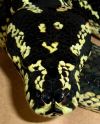
![]()
![]()
Southern Green python - Morelia viridis
Green Tree pythons have an average adult size of 3-4.5’ making them one of the truly small pythons. As it name suggests the southern Green python inhabits areas with suitable habitat of New Guinea south of the central dividing range as well as the Aru Island archipelago. There are also a couple small likely remnant populations found on the Cape York peninsula of Australia. Green Tree pythons are predominantly a green colored species with varying amounts of blue, White, and Yellow. The babies of the southern species are all yellow and the adults of this species are typically green with a white stripe along the spine and some blue speckling and blotches as well. The completeness of the white stripe does vary from almost nothing to a complete unspoken stripe. In the Aru race the white stripe is replaced with varying amounts of white speckling.
My group ~ My focus is on doing a high white Aru project. So far I am seeing some promising results and if I can develop a line of Aru’s that consistently produces specimens that are high white it will be very exciting.
Jungle Carpet python - Morelia s. cheynei
Jungle carpets are one of the smaller forms of carpet python with adults averaging 3.5-6’. Jungle carpet pythons come from a couple very small regions of tropical northeast Queensland Australia. places such as Tully Gorge, Mission Beach, Palmerston, Julatten, and Atherton Tablelands are some of the main localities you hear about when researching this snake. The look of Jungle carpets like that of the other carpets is highly variable. A pattern of yellow or gold that is banded, striped, and or a combination of the two along with varying amounts of speckling on a black background is common with this snake in captivity. What has come to be expected in looks for captive JCp's is not an accurate representation of the species in nature but are the results of selective breeding for the traits we find appealing. Being one of the most beautiful of all the pythons makes them a welcome addition to any reptile collection.
My group ~ Currently I keep a very small group of a very rare and distinct bloodline but they are old and I am not sure they will ever reproduce successfully.
Papuan Carpet python - Morelia s. harrisoni*
Papuan Carpets are a medium size pythons with adults averaging 4.5-6’. This snake is found in several remnant populations along the southeastern coast of the Island of New Guinea. A couple of the populations are on the papua New Guinea side and are not available in captivity. The population from the Indonesian governed side of West papua is the origin of our captives. The pattern can be banded or striped with a base color of various brown shades and a cream to straw pattern that is framed with a black border. Babies are a bright Red and cream when they hatch and undergo an interesting color shift as they mature. Intensive selective breeding could yield some amazing results as there are some truly stunning examples of this species in several collections.
My group ~ Currently I keep a pair of Het for the Granite morph.
Darwin Carpet - Morelia s. variegata
Darwin carpets like most of the other carpets average 4.5-6’ as adults. In nature they inhabit northern Australia from the Kimberley region in the northwest as well as to the northeast in parts of the Cape York peninsula. A banded pattern appears to be the more prominent appearance but striped specimens do occur as well. The base coloration is a very deep orange to light brown with the lighter cream pattern sections framed with a black border. Hatchlings are a deep burnt red color and they undergo an interesting color shift as they mature. They are quite distinctive and when you see one you will know it. These are becoming more readily available in US collections and with the albino morph originating in this sub species they will undoubtedly become very popular but right now they are still quite rare in collections.
My Group ~ Currently I keep a pair of this interesting carpet python.
Bredls python - Morelia bredli
Bredls pythons are a more robust medium sized species with adults averaging 6-8’. This species is endemic to a relatively small area of the south central portion of the Northern Territory of Australia. This predominantly banded species displays a reddish brown base color with creamy straw colored patterned areas that are bordered in black. In many specimens the black border overtakes the reddish base color toward the posterior. With the color potential this species naturally has to offer it is a shame that more selective breeding has not been done. Most specimens have a very nice temperament and they are ideal pet pythons for anyone seeking an interesting captive.
My group ~ Currently I have one pair of het for the genetic stripe morph of this species.














































